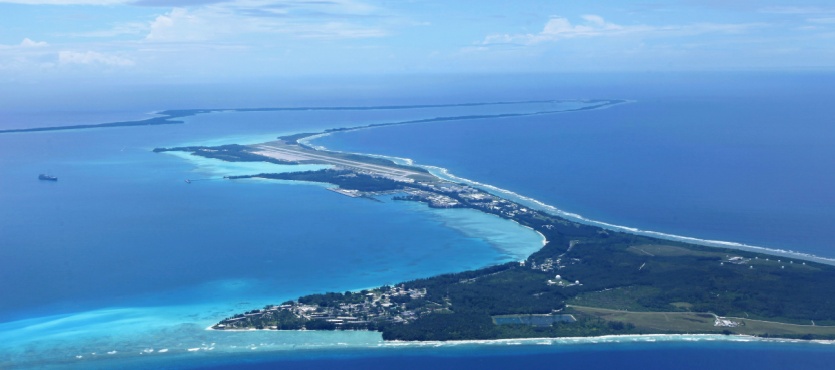Thousands of people live at a strategically vital military base that has a controversial past. Most people know nothing about this base or its past.
In the words of Robert Kaplan, the Indian Ocean will be “center stage for the twenty-first century.” “Like a microcosm of the world at large, the greater Indian Ocean region is developing into an area of both ferociously guarded sovereignty (with fast-growing economies and militaries) and astonishing interdependence (with its pipelines and land and sea routes).”
Due to its location in the very center of the Indian Ocean, Diego Garcia functions as a critical logistics hub for both the United States as well as the United Kingdom, which currently holds the island as an overseas territory. Its central location allows for rapid deployment of military forces to project power outward across the Middle East, East Africa, and South Asia, as well as providing a key refueling and supply station for naval and air operations. Bombers flown from Diego Garcia participated in the Gulf War, the invasion of Iraq and the war in Afghanistan.
The island is strategically valuable and politically controversial. On October 23, 2024, Prime Minister Keir Starmer unexpectedly announced that “a political agreement for the future” with the government of Mauritius had been concluded.
The new Secretary of State in the Trump administration, Marco Rubio, has said that the agreement to return sovereignty to Mauritius raises a “serious threat.” On one hand, as the authors of the international order and the international bodies that have issued the various advisory opinions mentioned above, the United States and United Kingdom acknowledge the positions and interests of all involved, including the Chagossians. On the other hand, significant national security issues hang in the balance as does the stability of the region and the protection of free passage in the sea lanes.
Diego Garcia’s Military Significance
The Malacca Strait in Indonesia is 4,000 miles from Diego Garcia. The Strait of Hormuz, at the tip of the Arabian Peninsula, is 2,500 miles from Diego Garcia. These distances seem impossibly long, but for modern aircraft and drones, they are a hop, skip, and a jump. Since this dot in the Indian Ocean is so militarily significant, its military facilities must be constantly updated to keep pace with weapons development. Private contractors usually answer the bell in these situations.
Many private contractors carry laptops or screwdrivers instead of hand grenades and machine guns. Contractors maintain advanced weapons systems and ensure that a base’s facilities accommodate these systems.
Contractors are in a good position to maintain advanced weapons systems. They understand their use in the field and know how servicemembers and other contractors operate them. Furthermore, in many canvases, private contractors worked for the company that designed and/or built the weapons. So, contractors know them inside and outside.
Everything needs a home, and “everything” includes advanced jets, drones, and other weapons. So, bases like Diego Garcia are almost constantly under construction. At any given time, something is being demolished, renovated, or built.
In many places, contractors supervise construction work. But because of the island’s remote location, many Diego Garcia contractors pull double duty and also perform the necessary work.
Construction consistently ranks as one of the world’s most dangerous occupations. These hazards are multiplied in isolated places like Diego Garcia. More on that below.
Diego Garcia’s Past
Contractors are flexible operators who are above politics. That trait is important for Diego Garcia.
Diego Garcia was discovered by Portuguese sailors in 1512 and remained uninhabited until the French began using it as a leper colony and for coconut plantations in the late 18th century. After the Napoleonic Wars, the island was transferred to British control. It remained part of Mauritius until 1965, when it suddenly became part of the newly formed BIOT (British Indian Ocean Territory).
In the early 1960s, less than 1,000 people, a mixture of native Chagos people and contract workers on coconut plantations, lived on Diego Garcia, the largest island in the Chagos Archipelago. Meanwhile, in a galaxy far, far away, the UK was releasing its iron grip on many of its remaining overseas possessions. However, it agreed to permit the United States to establish a naval communication station on one of its island territories in the Indian Ocean. Eventually, the UK and the United States agreed that Diego Garcia was a suitable location. Native Chagossians were left out of this conversation.
On December 30, 1966, the two countries agreed to a 70-year lease. Shortly thereafter, British authorities forcibly relocated the Chagossian inhabitants to make way for a military base. In 2019, the International Court of Justice ruled that the UK’s administration of the Chagos Archipelago was illegal and Diego Garcia properly belongs to Mauritius, a decision supported by the United Nations. The UK dismissed the ruling as non-binding.
To many, American servicemembers on Diego Garcia are instruments of an imperialist government that illegally poached territory from its rightful owner. But contractors are men and women who are on the island to do a job.
Injury Compensation Available
Medical bill payment is one of the most important benefits a Defense Base Act lawyer can obtain. When deployment-related injuries or illnesses arise in a place like Diego Garcia, the resulting medical bills are usually much higher.
Military facilities on Diego Garcia are very advanced, thanks to private contractors. But medical facilities are rather primitive. Frequently, a base hospital is not much more than a first aid station.
As a result, these victims must receive treatment at another hospital that is usually several thousand miles away. A few thousand miles is not much in military terms, as mentioned above. But a few thousand miles makes a world of difference in medical affairs. Serious injuries become catastrophic (life-threatening) ones.
Intensified emergency medical treatment has effects throughout the rest of the medical treatment life cycle. Victims require more follow-up care. Physical therapy becomes longer and more expensive. The need for ancillary medical care, such as prescription drugs and medical devices, multiplies as well.
These intensifications often create problems during the injury settlement process. As mentioned, construction injuries, like falls, are very common. Because of the aforementioned logistical concerns, the same fall in Denver costs much less to treat. Frequently, insurance adjusters do not account for this difference. So, a Defense Base Act lawyer must advocate for the victim.
This advocacy usually includes an Administrative Law Judge appeal hearing. An initial settlement conference is basically a paper review, but an ALJ appeal is basically a trial. At ALJ hearings, Defense Base Act lawyers can introduce evidence, challenge evidence, and present legal arguments.
For more information about DBA eligibility, contact Barnett, Lerner, Karsen, Frankel & Castro, P.A.

